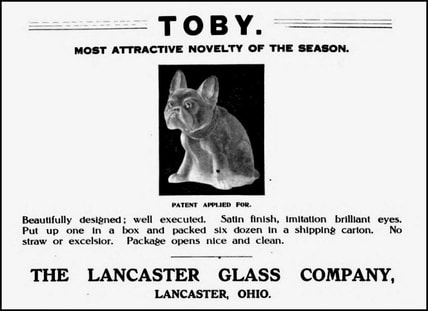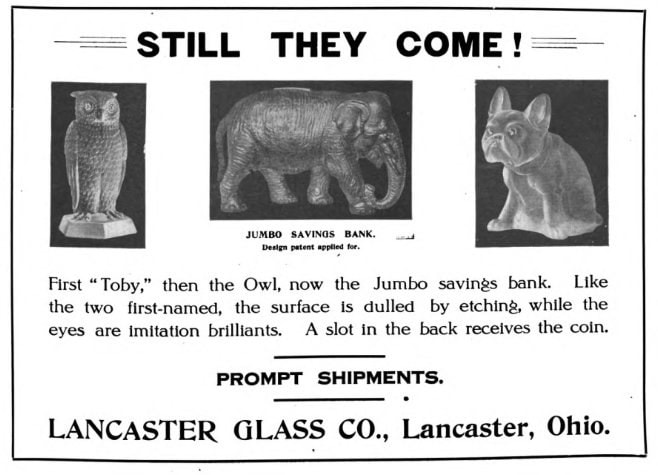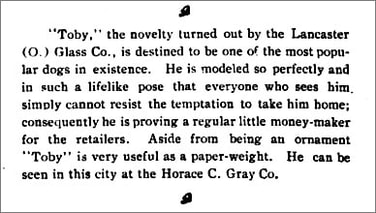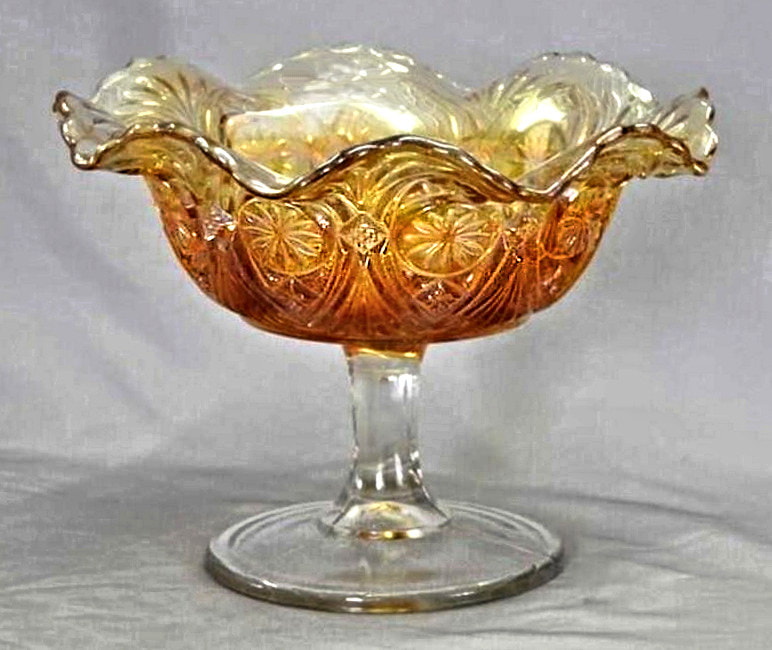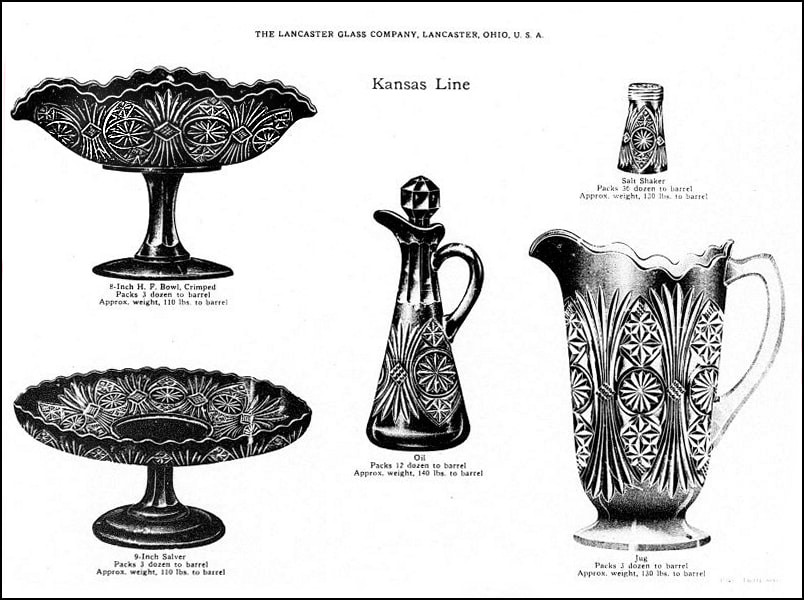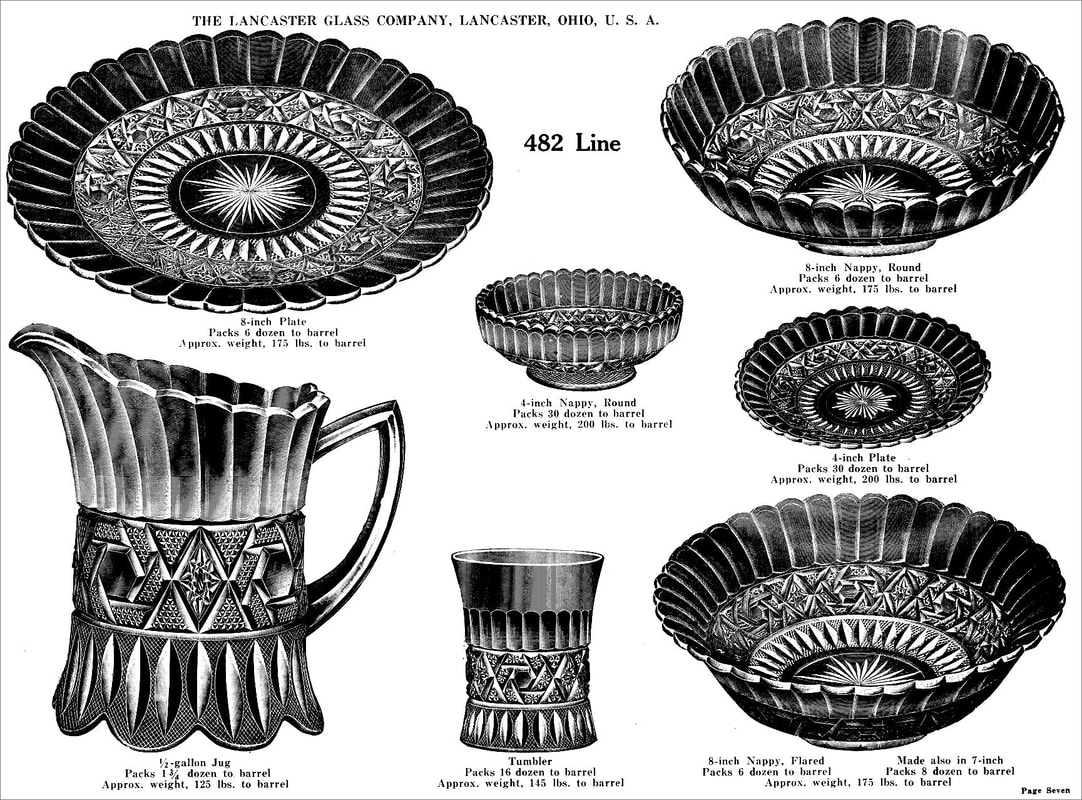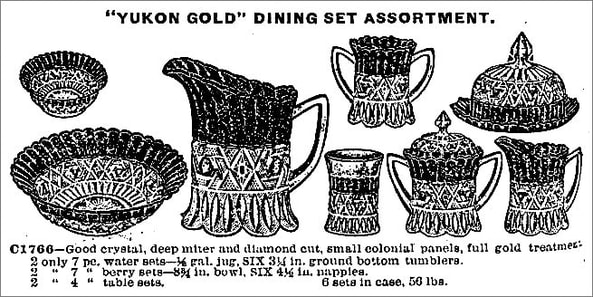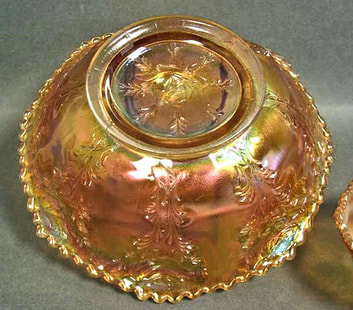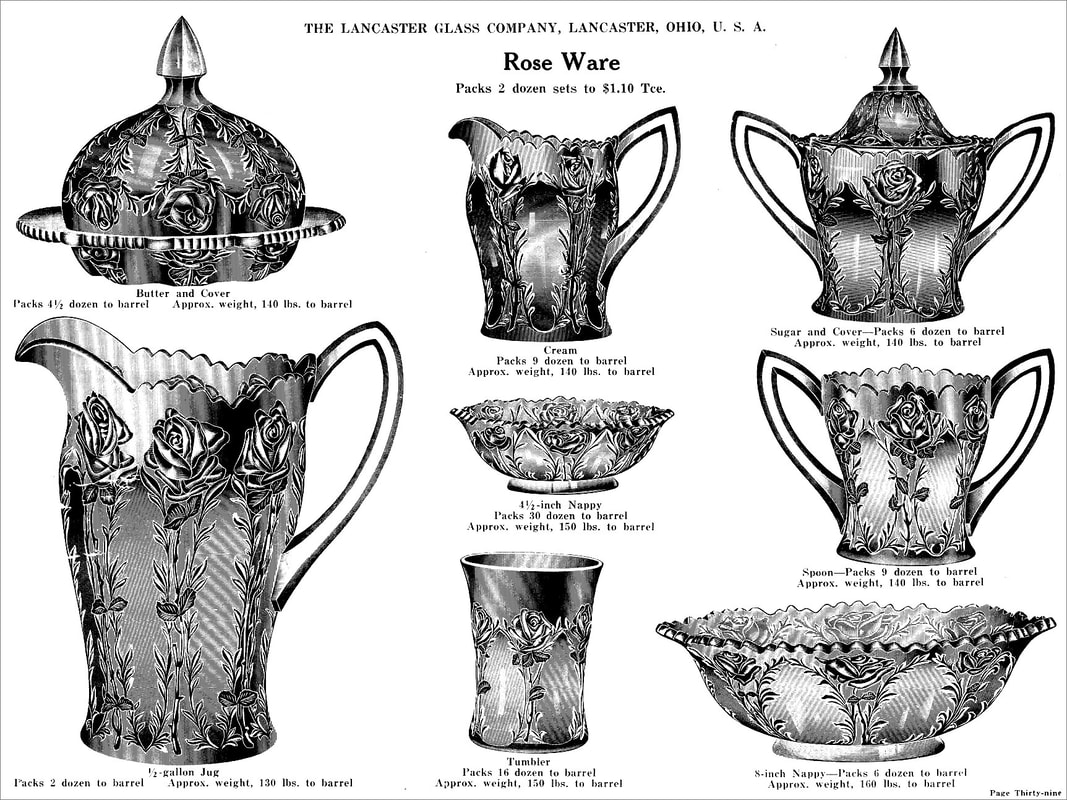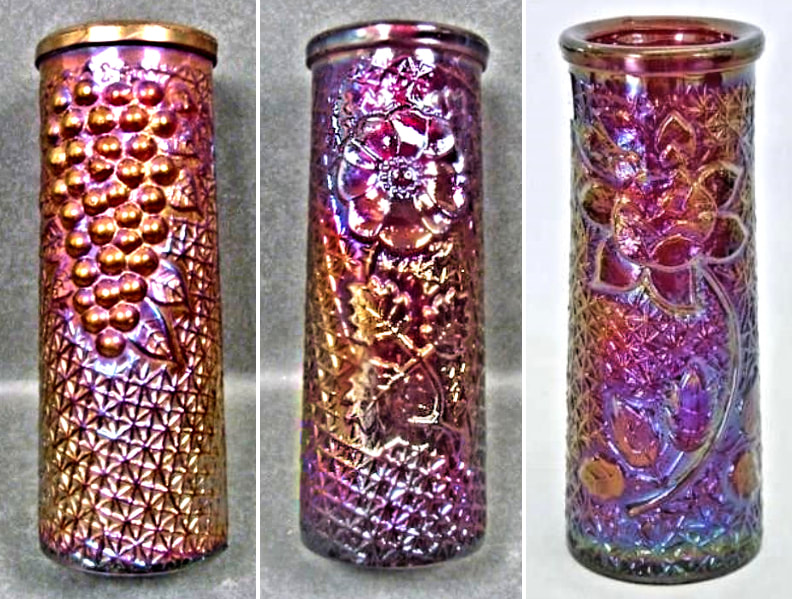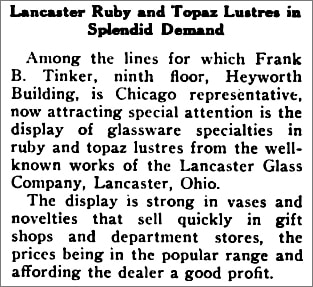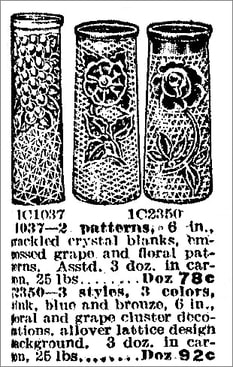The Lancaster Glass Company, Ohio
Copyright G&S Thistlewood, January 2024.
Lancaster Glass Company may not be a familiar name to Carnival Glass collectors, as they made only a relatively limited range of Carnival Glass - pressed, iridised glass with a moulded pattern - dating probably from around 1910-15. However, their later iridescent Stretch Glass lines dating from the 1920s, are known to many in shapes such as comports, candies and bonbons.
|
Before we reveal their Carnival Glass output, let’s take a brief look at the fascinating story behind the glassworks itself … starting with a log cabin. Martin of Martins Ferry In 1791, Ebenezer Martin was born in a log cabin above the banks of the Ohio River opposite the town of Wheeling. His family were early settlers in the region and young Ebenezer was destined to make his own mark in the area. The local town – known as Jefferson – was redesigned by Martin in a grid system, and became known as Martinsville. Soon after, due to the fact that Ebenezer Martin operated a popular ferry (a flatboat propelled with oars or poles) the town became known as Martins Ferry. Ebenezer fathered seventeen children, the youngest of which was called Lucien. Glass historian, Minnie Watson Kamm wrote (in the late 1950s) that “Lucien started his career as a salesman for Hobbs Brockunier and Co., soon becoming its star salesman.” In 1887 Martin was co-founder of The Fostoria Glass Co., moving on later to the National. Then, in 1908, Lucien Martin founded The Lancaster Glass Company with his son, Philip. The local area was a good choice for glass making as it had much natural gas and plentiful local sand. |
Illustration from The Lancaster Glass Co. catalogue.
Courtesy Glass Paper Fanatics. |
Lancaster Glass is also known for its novelty items, such as the splendid bulldog called "Toby", scarce examples of which are reported in marigold Carnival.
|
Above: Lancaster Glass had a representative on Fifth Avenue, New York.
Left: "Toby" was very eloquently described in this 1915 excerpt from the Crockery and Glass Journal. The author surely could not have expected the ongoing success of such a dog novelty figurine; a miniature version like this "paperweight" one has been produced by various makers over the years, as has a larger "doorstop" version in the same style.
|
A similar novelty bulldog, just under 3 inches high, was also made by Westmoreland (c. 1916) and Fenton (a few years later). To distinguish between them look at the bulldog’s collar! If the buckle on it is on the dog’s right side, it’s Lancaster - on the left side is Westmoreland and Fenton. Further information from James Measell indicates that three dots in a triangle under the buckle indicate Westmoreland while a circle of several dots means Fenton. Revival era versions are also known in a variety of Carnival colours.
A similar novelty bulldog, just under 3 inches high, was also made by Westmoreland (c. 1916) and Fenton (a few years later). To distinguish between them look at the bulldog’s collar! If the buckle on it is on the dog’s right side, it’s Lancaster - on the left side is Westmoreland and Fenton. Further information from James Measell indicates that three dots in a triangle under the buckle indicate Westmoreland while a circle of several dots means Fenton. Revival era versions are also known in a variety of Carnival colours.
Lancaster’s Carnival Glass
Let us now look at more Carnival Glass that was made by Lancaster Glass Co. It’s evident that iridescent glass – Carnival – was in the line at Lancaster in 1909, as the January 9th 1909 edition of “China, Glass and Lamps” featured a line of vases by Lancaster in “Crystal, Iridescent, Lustre and Ruby”*. However, so far very little of it is documented or recognised.
In this article, we feature several Lancaster patterns along with the catalogue evidence of their manufacturer. Our readers will be able to spot these items should they come across them in future.
Let us now look at more Carnival Glass that was made by Lancaster Glass Co. It’s evident that iridescent glass – Carnival – was in the line at Lancaster in 1909, as the January 9th 1909 edition of “China, Glass and Lamps” featured a line of vases by Lancaster in “Crystal, Iridescent, Lustre and Ruby”*. However, so far very little of it is documented or recognised.
In this article, we feature several Lancaster patterns along with the catalogue evidence of their manufacturer. Our readers will be able to spot these items should they come across them in future.
|
The Fishnet Vases
These are a trio of cylinder vases in red base glass, each standing around 6 inches high. A floral or fruit pattern is moulded on each, against a “fishnet” or crackle or lattice type of background. Confusingly, the names assigned to them vary. They are shown on the right, and the various names that have been given to them are: Fishnet Grape, aka Latticed Grape (Don Moore), aka Vineyard & Fishnet. Fishnet Poppy, aka Flaming Poppy (Don Moore), aka Fishnet Primrose, Primrose & Fishnet, aka Poppy & Fishnet, aka #2475. Fishnet Rose, aka American Beauty Rose (Don Moore), aka Fishnet Waterlily, aka Rose & Fishnet. Writing in 1986 in an article on red glass, Carnival Glass Pioneer Don Moore attributed them to Imperial. But we cannot find any evidence to support this. It is not clear what information was available to support the attribution to Imperial, and unfortunately this attribution has been repeated in many references online and in Carnival Glass literature, without further review, but our research suggests they were made by Lancaster Glass. |
Left to right: Fishnet Grape, Fishnet Poppy, both courtesy Burns Auctions;
Fishnet Rose, courtesy Seeck Auctions. All in red Carnival. |
The evidence to support our attribution to Lancaster Glass.
Our key evidence comes from a most interesting extract from the 1916 Charles Broadway Rouss mail order catalogue shown here below, right. It clearly depicts two of these vases – Fishnet Grape and Fishnet Rose.
Although the descriptive text suggests that there were being made in Goofus glass at that time, the crucial piece of information is at the foot of the ad: “Shipped from Lancaster, Ohio”, which was the precise location of The Lancaster Glass Company's factory.
Our key evidence comes from a most interesting extract from the 1916 Charles Broadway Rouss mail order catalogue shown here below, right. It clearly depicts two of these vases – Fishnet Grape and Fishnet Rose.
Although the descriptive text suggests that there were being made in Goofus glass at that time, the crucial piece of information is at the foot of the ad: “Shipped from Lancaster, Ohio”, which was the precise location of The Lancaster Glass Company's factory.
|
We believe this is contemporaneous and firm proof that the Fishnet vases were made by Lancaster Glass. A crucial feature of (some) Charles Broadway Rouss catalogues stated clearly where the glass assortments were being shipped from! So, for example, a glass assortment in the Rouss catalogue that we definitively know to be from the Fenton factory stated "Shipped from Williamstown W Va" (where Fenton were located) – similarly, Imperial assortments were described as “Shipped from Bellaire, O” (where the Imperial factory was located). Supplementary evidence also leads us to Lancaster Glass.
|
Above: extract from 1916 Charles Broadway Rouss mail
order catalogue. Courtesy Tom Felt and the EAPG Society. |
|
When might the Carnival Glass "Fishnet Vases" have been made? All three vases were depicted in Butler Brothers ads in 1923, 1924 and 1927 (and probably in other years too). The clearest one to view is shown on the right. Given that the iridised examples of these vases are all on red base glass, it seems most likely that the Carnival versions were made in the early 1920s, which is when pressed and iridised red glass was being produced. Our ground-breaking research into the making of iridised, pressed red Carnival, revealed that the techniques to produce a consistent cherry red colour came about only with the introduction of selenium into the glassmaking batch in the early 1920s. Here is a link to the article: The use of selenium in red Carnival. Put all these pieces of evidence together and the conclusion is that Lancaster Glass was the maker of the "Fishnet Vases". Orizaba pattern – maker uncertain This one is not proven to be made by Lancaster Glass, but we include it here for readers to make their own decision. A handled celery is shown in the Lancaster catalogue with the pattern name “Orizaba”. It is the only shape in this pattern that we have been able to see in any of the Lancaster catalogues or archive that we have studied, so we are unable to confirm any other shapes in this pattern. |
Above: 1927 Butler Brothers catalogue.
|
|
Left: extract from Lancaster catalogue showing the Orizaba celery, courtesy Glass Paper Fanatics, and right: Hobstar Band celery, courtesy Burns Auctions.
|
It has been suggested that Lancaster Glass may be the possible maker of Hobstar Band, however there are many significant differences between Hobstar Band and Orizaba. Note the major differences between the two: the handles are significantly different, the base is flat on the Orizaba while Hobstar Band has a collar and of course, there is a wide plain band at the top of the Orizaba that’s missing on Hobstar Band. A further observation regarding the handles. The Hobstar Band handles are facetted and complex while the Lancaster Orizaba handles are smooth and plain. All the many examples of handled tableware items and pitchers in the Lancaster catalogues that we have studied were plain and smooth. None were facetted and complex like those on Hobstar Band water pitchers. It is entirely possible that one was a copy or was inspired by the other – and that two different makers were involved. Without further proof we feel it is not safe to claim that Lancaster made Hobstar Band. |
Based on the evidence currently available, we feel that there are too many differences to claim Hobstar Band as a Lancaster pattern.
More Lancaster Glass Co.'s patterns were identified and revealed in our NetworK ezine, here: NetworK #106

